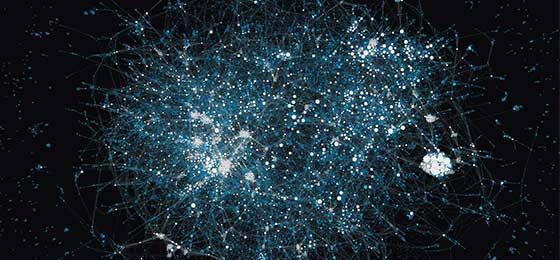The Swiss research galaxy

Every research project financed by the SNSF between 2006 and 2015 has been compiled into an infographic. In total it contains 355,000 collaborations, 45,000 researchers and 25,000 projects. It is the brainchild of Martin Grandjean of the University of Lausanne (UNIL) and appeared within a few days of the publication of the People, Projects and Publications, or P3 database.
(From "Horizons" no. 109 June 2016)
The nodes represent researchers, and their size depicts the total number of projects in which they were involved. The darker to lighter shading is used to represent the number of collaborations, which themselves are described by the lines.
One can make out individual communities in the central network, but the centre is no denser than its periphery. In fact, there are far-reaching satellites made up of scientists whose names appear on only a small number of research projects or whose work stems from very small teams composed of relatively secluded researchers.
The various domains of research can be seen in the structure of the network. Medical and computing sciences are concentrated on the left, whereas chemistry and biology are at the top, earth and physical sciences on the right, and human and social sciences on the left.
"It's basically a structural analysis", says Grandjean. "We need to add qualitative layers systematically, such as the domains, institutions and even the mobility of researchers, so as to bring out the full meaning of the visualisation. The data will be linked to a database containing every scholar in Switzerland, allowing a more detailed analysis. This will be done in collaboration with Pierre Benz and Thierry Rossier of the Swiss Elite Observatory at UNIL".
dsa